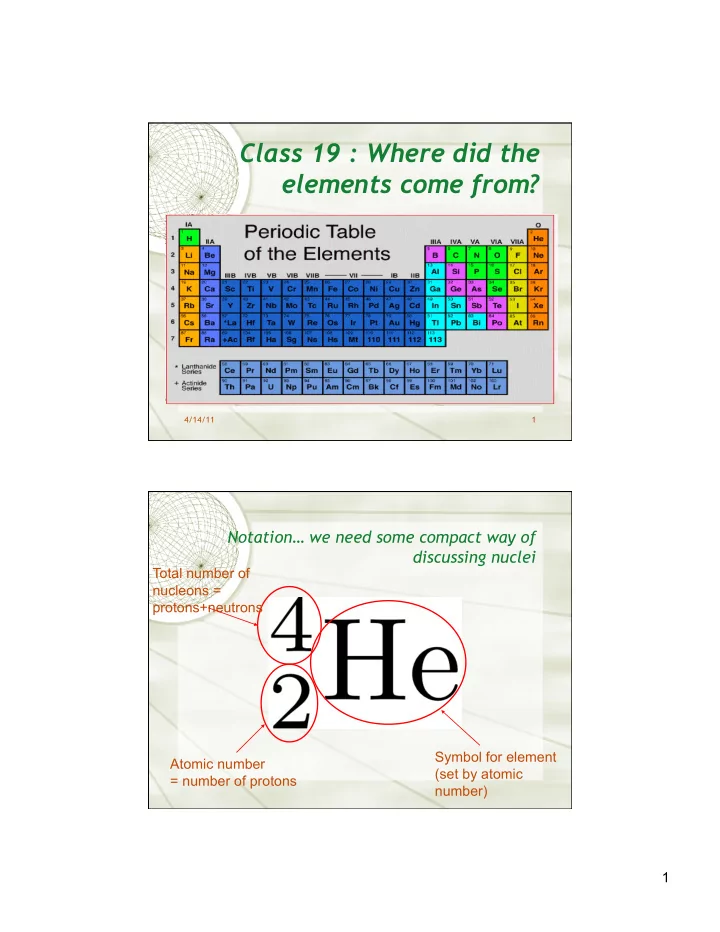

Class 19 : Where did the elements come from? 4/14/11 1 Notation… we need some compact way of discussing nuclei Total number of nucleons = protons+neutrons Symbol for element Atomic number (set by atomic = number of protons number) 1
NUCLEOSYNTHESIS IN THE EARLY UNIVERSE Nucleosynthesis: the production of different elements via nuclear reactions Consider universe at t=180s i.e. 3 minutes after big bang Universe has cooled down to 1 billion (10 9 ) K Filled with Photons (i.e. parcels of electromagnetic radiation) Protons (p) Neutrons (n) Electrons (e) [also Neutrinos, but these were freely streaming] 4/14/11 3 The first three minutes… Protons and Neutrons can fuse together to form deuterium (d) But, deuterium is quite fragile… Before t=180s, Universe is hotter than 1 billion degrees. High-T means that photons carry a lot of energy Deuterium is destroyed by energetic photons as soon as it forms 4/14/11 4 2
After the first 3 minutes… But, after t=180s, Universe has cooled to the point where deuterium can survive Deuterium formation is the first step in a whole sequence of nuclear reactions: e.g. Helium-4 ( 4 He) formation: 4/14/11 5 An alternative pathway to Helium… This last series of reactions also produces traces of left over “light” helium ( 3 He) 4/14/11 6 3
Further reactions can give Lithium (Li) Reactions cannot easily proceed beyond Lithium 4/14/11 7 If this were all there was to it, then the final mixture of hydrogen & helium would be determined by initial number of p and n. If equal number of p and n, everything would basically turn to 4 He… Pairs of protons and pairs of neutrons would team up into stable Helium nuclei. Would have small traces of other species But we know that most of the universe is hydrogen… why are there fewer n than p? What else is going on? 4/14/11 8 4
Balance of p and n Protons are more common than neutrons (86% of baryons are p, 14% are n) because: 1. Protons are slightly lower mass thus favored energetically, so they were somewhat more abundant to begin with 2. Free neutrons decay quickly 4/14/11 9 Neutron decay Free neutrons (i.e., neutrons that are not bound to anything else) are unstable! Neutrons spontaneously and randomly decay into protons, emitting electron and neutrino Half life for this occurrence is 10.5 mins (i.e., take a bunch of free neutrons… half of them will have decayed after 10.5 mins). 4/14/11 10 5
While the nuclear reactions are proceeding, supply of “free” neutrons is decaying away. So, speed at which nuclear reactions occur is crucial to final mix of elements What factors determine the speed of nuclear reactions? Density (affects chance of p/n hitting each other) Temperature (affects how hard they hit) Expansion rate of early universe (affects how quickly everything is cooling off and spreading apart). 4/14/11 11 Full calculations are complex. Need to: Work through all relevant nuclear reactions Take account of decreasing density and decreasing temperature as Universe expands Take account of neutron decay Feed this into a computer… Turns out that relative elemental abundances depend upon the quantity Ω B H 2 Here, Ω B is the density of the baryons (everything made of protons+neutrons) relative to the critical density. 4/14/11 12 6
Dependence of abundances on Ω B H 2 From M.White’s webpage, UC Berkeley Ω B h 2 4/14/11 13 We can use the spectra of stars and nebulae to measure abundances of elements These need to be corrected for reactions in stars By measuring the abundance of H, D, 3 He, 4 He, and 7 Li, we can Test the consistency of the big bang model -- are relative abundances all consistent? Use the results to measure the quantity Ω B h 2 4/14/11 14 7
Results All things considered, we have Ω B h 2 ≈ 0.019. If H 0 =72km/s/Mpc, h=0.72 Ω B ≈ 0.04 This is far below Ω =1! Baryons alone would give open universe Ω B h 2 4/14/11 15 How are other elements formed? Big Bang Nucleosynthesis produces most of the hydrogen & helium observed today. But what about other elements? There are naturally occurring elements as heavy as Uranium Some elements (e.g., Carbon, Nitrogen, Oxygen) are rather plentiful (1 atom in every 10 5 atoms) Astronomers believe these elements were formed in the cores of stars long after the big bang Theory of stellar nucleosynthesis was first worked out by Burbidge, Burbidge,Folwer, & Hoyle in 1957 4/14/11 18 8
Stellar “burning” In the normal life of a star (main sequence)… nuclear fusion turns Hydrogen into Helium In the late stages of the life of a massive star… Helium converted into heavier elements (carbon, oxygen, …, iron) “Triple-alpha” process bridges stability gap from Be to C At end of star’s life, get an onion-like structure (see picture to right) 4/14/11 19 Fusion of more and more massive nuclei 4/14/11 20 9
Iron, the most stable nucleus What’s special about iron? Iron has the most stable nucleus Fusing hydrogen to (eventually) iron releases energy (thus powers the star) Further fusion of iron to give heavier elements would require energy to be put in… Can only happen in the energetic environment of a supernova explosion 4/14/11 21 Supernovae briefly outshine their parent galaxies 4/14/11 26 10
The Crab Nebula is the remnant of a SN that exploded in 1054 AD We directly see a new generation of heavy elements 4/14/11 27 Elemental abundance in the Sun 4/14/11 28 11
Recommend
More recommend